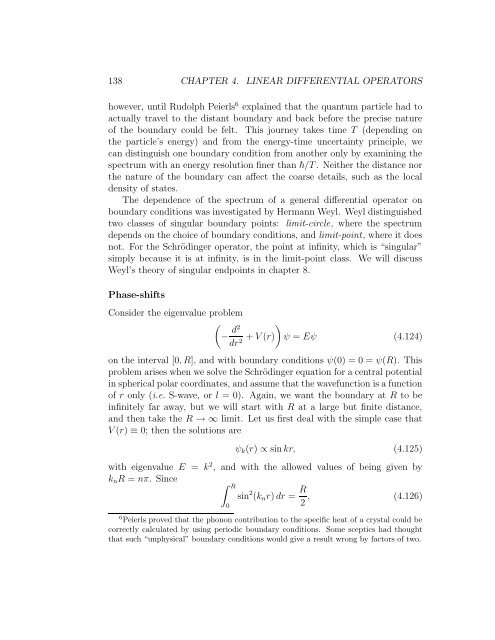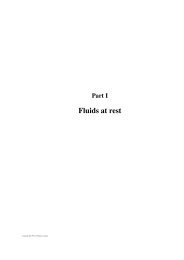Chapter 4 Linear Differential Operators
Chapter 4 Linear Differential Operators
Chapter 4 Linear Differential Operators
Create successful ePaper yourself
Turn your PDF publications into a flip-book with our unique Google optimized e-Paper software.
138 CHAPTER 4. LINEAR DIFFERENTIAL OPERATORS<br />
however, until Rudolph Peierls 6 explained that the quantum particle had to<br />
actually travel to the distant boundary and back before the precise nature<br />
of the boundary could be felt. This journey takes time T (depending on<br />
the particle’s energy) and from the energy-time uncertainty principle, we<br />
can distinguish one boundary condition from another only by examining the<br />
spectrum with an energy resolution finer than /T . Neither the distance nor<br />
the nature of the boundary can affect the coarse details, such as the local<br />
density of states.<br />
The dependence of the spectrum of a general differential operator on<br />
boundary conditions was investigated by Hermann Weyl. Weyl distinguished<br />
two classes of singular boundary points: limit-circle, where the spectrum<br />
depends on the choice of boundary conditions, and limit-point, where it does<br />
not. For the Schrödinger operator, the point at infinity, which is “singular”<br />
simply because it is at infinity, is in the limit-point class. We will discuss<br />
Weyl’s theory of singular endpoints in chapter 8.<br />
Phase-shifts<br />
Consider the eigenvalue problem<br />
<br />
− d2<br />
<br />
+ V (r) ψ = Eψ (4.124)<br />
dr2 on the interval [0, R], and with boundary conditions ψ(0) = 0 = ψ(R). This<br />
problem arises when we solve the Schrödinger equation for a central potential<br />
in spherical polar coordinates, and assume that the wavefunction is a function<br />
of r only (i.e. S-wave, or l = 0). Again, we want the boundary at R to be<br />
infinitely far away, but we will start with R at a large but finite distance,<br />
and then take the R → ∞ limit. Let us first deal with the simple case that<br />
V (r) ≡ 0; then the solutions are<br />
ψk(r) ∝ sin kr, (4.125)<br />
with eigenvalue E = k2 , and with the allowed values of being given by<br />
knR = nπ. Since<br />
R<br />
sin 2 (knr) dr = R<br />
,<br />
2<br />
(4.126)<br />
0<br />
6 Peierls proved that the phonon contribution to the specific heat of a crystal could be<br />
correctly calculated by using periodic boundary conditions. Some sceptics had thought<br />
that such “unphysical” boundary conditions would give a result wrong by factors of two.




